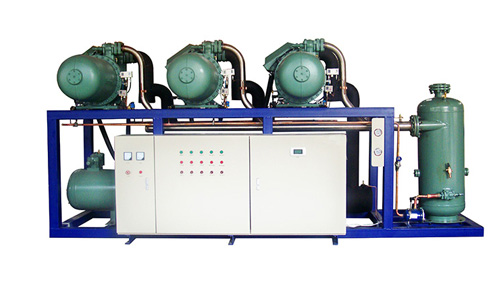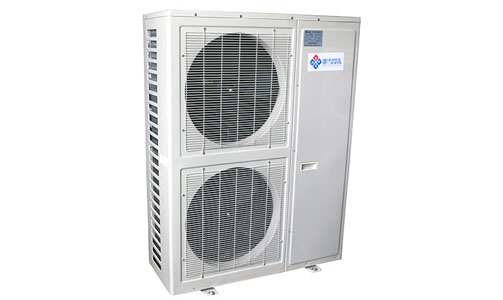Condensing units are essential components in refrigeration systems, providing the necessary cooling function in various applications, from residential air conditioning to large-scale industrial refrigeration. Choosing the right condensing unit and sizing it correctly ensures optimal efficiency, reliability, and cost-effectiveness. This article will guide you through the process of selecting and sizing a condensing unit for your specific needs.
What is a Condensing Unit?
A condensing unit is a critical part of a refrigeration system, responsible for rejecting heat absorbed from the space being cooled. It consists of a compressor, condenser coil, and fan, all housed together in a single unit. The compressor circulates refrigerant through the system, while the condenser coil releases heat, and the fan helps to expel this heat into the surrounding air. These units are commonly used in air conditioning systems, commercial refrigerators, and cold storage facilities.
Factors to Consider When Choosing a Condensing Unit
When selecting a condensing unit, several factors must be taken into account to ensure that the system performs efficiently and meets your requirements. Here are the most important considerations:
1. Cooling Capacity
The cooling capacity is one of the most critical aspects when choosing a condensing unit. It determines the unit's ability to remove heat from the space being cooled. Cooling capacity is measured in BTUs (British Thermal Units) or kW (kilowatts), and it must be matched to the heat load of the space you intend to cool.
How to choose: Calculate the total heat load of your system based on factors like room size, insulation, ambient temperature, and the type of equipment being used. You can consult with a professional or use an online BTU calculator to estimate the required cooling capacity.

Copeland Air-Cooled Scroll Type Condensing Unit (5~15℃)
2. Energy Efficiency
Energy efficiency is another important consideration when selecting a condensing unit. An efficient unit will consume less power, resulting in lower operating costs and a reduced environmental impact.
How to choose: Look for condensing units with high energy efficiency ratings. Units that are ENERGY STAR certified or have a high SEER (Seasonal Energy Efficiency Ratio) or COP (Coefficient of Performance) typically provide better energy performance.
3. Refrigerant Type
Refrigerants are substances used in refrigeration systems to absorb and release heat. Different refrigerants have varying environmental impacts and energy efficiencies.
How to choose: Common refrigerants include R-410A, R-134A, and R-22, with R-410A being one of the most commonly used due to its efficiency and lower environmental impact compared to R-22. However, some older systems may still use R-22, which is being phased out due to its ozone-depleting properties.
4. Noise Level
Condensing units can generate noise during operation, which might be a concern depending on the installation location. Noise can be especially disruptive in residential areas or near noise-sensitive environments.
How to choose: Look for units that offer quiet operation or have noise-reducing features. Many modern units are designed to minimize sound, and manufacturers often provide noise-level specifications, typically measured in decibels (dB). Be sure to choose a unit with an acceptable noise level for your environment.
5. Size and Space Availability
The physical size of the condensing unit is an important consideration, especially when space is limited. A unit that is too large may not fit within the available space, while one that is too small may not provide the necessary cooling capacity.
How to choose: Measure the space available for installation and ensure the condensing unit fits comfortably while providing adequate airflow. Be sure to consider the necessary clearance around the unit for proper ventilation and maintenance access.
6. Installation and Maintenance Requirements
Ease of installation and ongoing maintenance are factors that can affect the overall cost and long-term reliability of your condensing unit. Some units may require professional installation or regular servicing, while others are more straightforward to install and maintain.
How to choose: Opt for units that are easy to install and come with clear installation guidelines. Additionally, choose units with minimal maintenance needs, or ensure that replacement parts are readily available. Many modern units are designed to be low-maintenance, with features like corrosion-resistant coatings and self-cleaning capabilities.
How to Size a Condensing Unit?
Properly sizing a condensing unit is crucial to ensure efficient operation and avoid unnecessary energy consumption. An oversized or undersized unit can lead to performance issues, higher energy bills, and reduced system lifespan. Here’s how to size a condensing unit for your needs:
1. Determine the Heat Load
The first step in sizing a condensing unit is to determine the total heat load of the space being cooled. This includes calculating the amount of heat generated by appliances, lighting, occupants, and other sources. Professional cooling contractors often perform heat load calculations using software or manuals that factor in variables like insulation, room size, and local climate conditions.
2. Match Cooling Capacity with Heat Load
Once you’ve calculated the heat load, the next step is to match the cooling capacity of the condensing unit with the required heat removal rate. A unit’s cooling capacity is typically expressed in BTUs per hour or kW. Ensure that the unit’s cooling capacity is equal to or slightly higher than the calculated heat load. It's better to have a slightly oversized unit than one that is too small.
3. Consider Seasonal Variation
Cooling needs can vary based on the season, and the temperature fluctuations in your area should be considered when sizing the unit. In hotter climates, you may require a more powerful condensing unit, while cooler areas may need a unit with less capacity.
4. Account for Future Expansion
If you plan to expand your cooling needs in the future—such as adding more rooms, equipment, or appliances—consider sizing your condensing unit to accommodate future growth. This will help prevent the need for an upgrade shortly after installation.
Questions and Answers About Choosing and Sizing Condensing Units
Q: How can I tell if my condensing unit is too large or too small?
A: If your condensing unit is too large, it will short-cycle, turning on and off frequently, which reduces its lifespan and energy efficiency. If it’s too small, it won’t be able to cool the space effectively, leading to inadequate performance and higher energy consumption.
Q: Can I install a condensing unit myself?
A: While some smaller systems may be DIY-friendly, installing a condensing unit typically requires professional expertise, especially when it comes to connecting the refrigerant lines, ensuring proper airflow, and complying with local codes.
Q: How often should I service my condensing unit?
A: Condensing units should be serviced regularly—typically once or twice a year. This includes cleaning the coils, checking refrigerant levels, and inspecting components for wear. Regular maintenance ensures efficient operation and prolongs the life of the unit.
Conclusion
Choosing and sizing a condensing unit correctly is crucial for the efficient operation of refrigeration and air conditioning systems. By considering factors like cooling capacity, energy efficiency, refrigerant type, and the specific needs of your space, you can ensure that you select the right unit for your application. Proper sizing ensures your unit operates efficiently, saving you money in the long run and enhancing system reliability. Be sure to consult with professionals for detailed calculations and installation to get the best performance out of your condensing unit.







